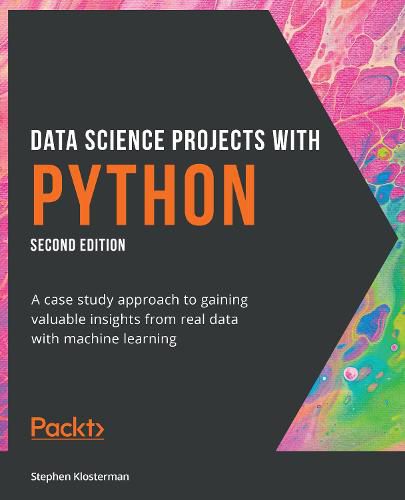Readings Newsletter
Become a Readings Member to make your shopping experience even easier.
Sign in or sign up for free!
You’re not far away from qualifying for FREE standard shipping within Australia
You’ve qualified for FREE standard shipping within Australia
The cart is loading…






This title is printed to order. This book may have been self-published. If so, we cannot guarantee the quality of the content. In the main most books will have gone through the editing process however some may not. We therefore suggest that you be aware of this before ordering this book. If in doubt check either the author or publisher’s details as we are unable to accept any returns unless they are faulty. Please contact us if you have any questions.
Gain hands-on experience of Python programming with industry-standard machine learning techniques using pandas, scikit-learn, and XGBoost
Key Features
Think critically about data and use it to form and test a hypothesis Choose an appropriate machine learning model and train it on your data Communicate data-driven insights with confidence and clarity
Book DescriptionIf data is the new oil, then machine learning is the drill. As companies gain access to ever-increasing quantities of raw data, the ability to deliver state-of-the-art predictive models that support business decision-making becomes more and more valuable.
In this book, you’ll work on an end-to-end project based around a realistic data set and split up into bite-sized practical exercises. This creates a case-study approach that simulates the working conditions you’ll experience in real-world data science projects.
You’ll learn how to use key Python packages, including pandas, Matplotlib, and scikit-learn, and master the process of data exploration and data processing, before moving on to fitting, evaluating, and tuning algorithms such as regularized logistic regression and random forest.
Now in its second edition, this book will take you through the end-to-end process of exploring data and delivering machine learning models. Updated for 2021, this edition includes brand new content on XGBoost, SHAP values, algorithmic fairness, and the ethical concerns of deploying a model in the real world.
By the end of this data science book, you’ll have the skills, understanding, and confidence to build your own machine learning models and gain insights from real data.
What you will learn
Load, explore, and process data using the pandas Python package Use Matplotlib to create compelling data visualizations Implement predictive machine learning models with scikit-learn Use lasso and ridge regression to reduce model overfitting Evaluate random forest and logistic regression model performance Deliver business insights by presenting clear, convincing conclusions
Who this book is forData Science Projects with Python - Second Edition is for anyone who wants to get started with data science and machine learning. If you’re keen to advance your career by using data analysis and predictive modeling to generate business insights, then this book is the perfect place to begin. To quickly grasp the concepts covered, it is recommended that you have basic experience of programming with Python or another similar language, and a general interest in statistics.
$9.00 standard shipping within Australia
FREE standard shipping within Australia for orders over $100.00
Express & International shipping calculated at checkout
This title is printed to order. This book may have been self-published. If so, we cannot guarantee the quality of the content. In the main most books will have gone through the editing process however some may not. We therefore suggest that you be aware of this before ordering this book. If in doubt check either the author or publisher’s details as we are unable to accept any returns unless they are faulty. Please contact us if you have any questions.
Gain hands-on experience of Python programming with industry-standard machine learning techniques using pandas, scikit-learn, and XGBoost
Key Features
Think critically about data and use it to form and test a hypothesis Choose an appropriate machine learning model and train it on your data Communicate data-driven insights with confidence and clarity
Book DescriptionIf data is the new oil, then machine learning is the drill. As companies gain access to ever-increasing quantities of raw data, the ability to deliver state-of-the-art predictive models that support business decision-making becomes more and more valuable.
In this book, you’ll work on an end-to-end project based around a realistic data set and split up into bite-sized practical exercises. This creates a case-study approach that simulates the working conditions you’ll experience in real-world data science projects.
You’ll learn how to use key Python packages, including pandas, Matplotlib, and scikit-learn, and master the process of data exploration and data processing, before moving on to fitting, evaluating, and tuning algorithms such as regularized logistic regression and random forest.
Now in its second edition, this book will take you through the end-to-end process of exploring data and delivering machine learning models. Updated for 2021, this edition includes brand new content on XGBoost, SHAP values, algorithmic fairness, and the ethical concerns of deploying a model in the real world.
By the end of this data science book, you’ll have the skills, understanding, and confidence to build your own machine learning models and gain insights from real data.
What you will learn
Load, explore, and process data using the pandas Python package Use Matplotlib to create compelling data visualizations Implement predictive machine learning models with scikit-learn Use lasso and ridge regression to reduce model overfitting Evaluate random forest and logistic regression model performance Deliver business insights by presenting clear, convincing conclusions
Who this book is forData Science Projects with Python - Second Edition is for anyone who wants to get started with data science and machine learning. If you’re keen to advance your career by using data analysis and predictive modeling to generate business insights, then this book is the perfect place to begin. To quickly grasp the concepts covered, it is recommended that you have basic experience of programming with Python or another similar language, and a general interest in statistics.